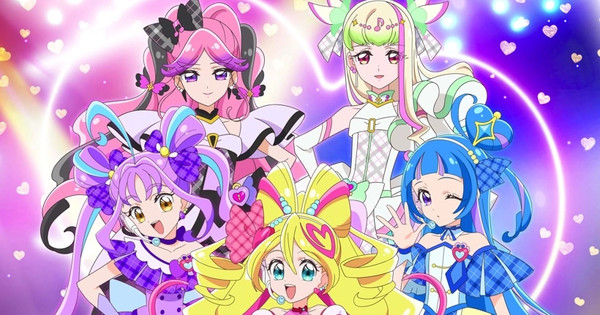Perhaps this is a “me” problem, but I had hoped for more from You and Idol Precure♪ in its second cour. Even recognizing that this is a lighter, fluffier season than those that preceded it, there’s something that feels a bit off here. It could be the character work, it could be the fact that it’s not fully engaging with its idol theme, or it simply could be that it’s not meshing with me personally as much as nearly every other season of Precure, but something about this simply isn’t working as well as it ought to, and that’s a shame.
That’s particularly true because You and Idol has some very strong elements in these episodes. Chief among them is Purirun’s storyline. While fairy characters have turned into humans before – it’s a central part of Yes! Precure 5 – and into Cures as well (Yes! Precure 5 Go Go and Kira Kira Precure a la Mode), You and Idol Precure♪ makes Purirun and Meroron’s transformation into something a bit more. For Purirun specifically, it’s done out of a desire to help Uta because she cares about her. It’s also about defeating the villains, but it’s primarily based on her love for her friend. It will also come at a steep cost: to gain the power to help, she and Meroron must use the Heart Kirari Lock, which requires that which they value the most in exchange. The price it claims from Purirun is her memories of Uta.
This is a classic magical girl moment. Throughout the history of the genre, going back as far as the 13th century text Tales of Gisho and Gangyo, where an early magical girl figure appears, magical girls have had to pay a price for their power. Sometimes that price is refunded, as in Nurse Angel Ririka SOS; sometimes it isn’t, as Puella Magi Madoka Magica delighted in showing. For Purirun, the important element is that she’s willing to make that sacrifice in the first place, exchanging her very reason for using the Lock for the power she desires. She thus begins her career as Cure Zukyoon without knowing why it’s so important to her, determined without fully understanding herself.
It’s also an interesting statement that the Lock only appears to claim its price from Purirun. Both she and Meroron use it together, but Meroron doesn’t pay an obvious tithe. That leads to a couple of potential explanations: she simply didn’t want a solution as badly as Purirun did, or her wish–for Purirun to return her romantic feelings–wasn’t “pure” enough. More ominously, her desire may have been twisted by the Lock, meaning that Purirun potentially loving her romantically has been sealed away as the price. By using the Lock, Meroron may have stopped her love from ever being requited.
That’s a tragic possibility, even if Meroron continues to be the most irritating character in the series with her overblown jealousy of Uta and Purirun’s friendship. But unlike Wonderful Precure!, You and Idol Precure♪ doesn’t seem particularly invested in potential romantic subplots, although we’re only halfway through the series. Hibiki is largely absent from this set, only really returning in the final two episodes, and while there’s room to interpret Uta’s fascination with Cure Zukyoon as a crush, that doesn’t seem to be what the show is going for; it seems more likely, based on Kokoro’s idol-loving, that Uta’s obsession is meant to show her fully understanding idol fandom for the first time. While I can see that that may be important to a degree, it also made for a couple of annoying episodes, and it might have been better shown in episode twenty-three, when Hibiki’s fans swarm Café Glitter and he and Cure Idol talk about how to treat fans – with the implication that he enjoys his time at Café Glitter because they just treat him like a person and that being “on” all the time is exhausting.
The use of idol culture (and possibly stan culture) gets some use with the villains in this cour. While one minion allows his love of the Idol Precures to overwhelm him, resulting in his purification, another struggles with the same idea. Chokkiri was something of a general fan, but Zakkiri is specifically into Cure Wink, and he’s not entirely comfortable with that. While the symbolic goal is doubtless to hype up the power of idols to reach their fanbases, for Zakkiri and NANA, things may be a little more complicated. Of all of the Cures, NANA is in the best position to understand the difference between who you are and who you present yourself as to the world, and that makes her uniquely sympathetic to Zakkiri’s issue. But she’s also fourteen, and that makes her vulnerable as well. This storyline is just getting started, but their interactions in episodes twenty-three and twenty-four have a lot of potential for both characters to grow.
While the art and animation are still a bit uneven, Cures Zukyoon and Kiss have even better character designs than Cures Idol, Wink, and Kyun-Kyun, and their theme colors (black and white), alongside their dual transformations, are a wonderful callback to the original Cures Black and White, merging the first Precure with the latest. The new ending theme has better choreography and camera angles, and the music continues to be catchy, even if it’s not the absolute best the franchise has offered. I’m still a bit disappointed with this series, which offsets its good points with awkward pacing and a few annoying elements without digging into the darker side of idol culture as much as it could, even for an intended audience of children. Still, it has potential. And if there’s one thing years of studying, reading, and watching magical girl stories has taught me, it’s that you always have to hold on to hope.

